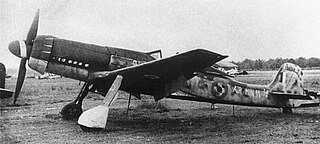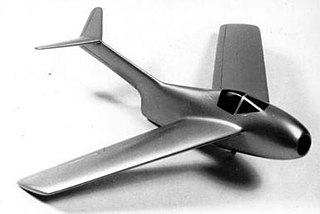
The Heinkel He 162 Volksjäger is a German single-engine, jet-powered fighter aircraft fielded by the Luftwaffe late in World War II. Developed under the Emergency Fighter Program, it was designed and built quickly and made primarily of wood as metals were in very short supply and prioritised for other aircraft. Volksjäger was the Reich Air Ministry's official name for the government design program competition won by the He 162 design. Other names given to the plane include Salamander, which was the codename of its wing-construction program, and Spatz ("Sparrow"), which was the name given to the plane by the Heinkel aviation firm.

The Focke-Wulf Fw 190, nicknamed Würger (Shrike) is a German single-seat, single-engine fighter aircraft designed by Kurt Tank at Focke-Wulf in the late 1930s and widely used during World War II. Along with its well-known counterpart, the Messerschmitt Bf 109, the Fw 190 became the backbone of the Jagdwaffe of the Luftwaffe. The twin-row BMW 801 radial engine that powered most operational versions enabled the Fw 190 to lift larger loads than the Bf 109, allowing its use as a day fighter, fighter-bomber, ground-attack aircraft and to a lesser degree, night fighter.

The Focke-Wulf Ta 152 is a World War II German high-altitude fighter–interceptor designed by Kurt Tank and produced by Focke-Wulf. The Ta 152 was a development of the Focke-Wulf Fw 190 aircraft. It was intended to be made in at least three versions—the Ta 152H Höhenjäger ; the Ta 152C designed for medium-altitude operations and ground-attack, using a Daimler-Benz DB 603 and with smaller wings and the Ta 152E fighter–reconnaissance aircraft with the engine of the H model and the wing of the C model. The first Ta 152H entered service with the Luftwaffe in January 1945. The Ta 152 was produced too late and in insufficient numbers to have a significant role in the war.

The BMW 803 was a German aircraft engine, an attempt by BMW to build a high-output aircraft engine by coupling two BMW 801 engines back-to-back, driving contra-rotating propellers. The result was a 28-cylinder, four-row radial engine, each comprising a multiple-bank in-line engine with two cylinders in each bank, which, due to cooling concerns, were liquid cooled.

The Junkers Jumo 213 was a World War II-era V-12 liquid-cooled aircraft engine, a development of Junkers Motoren's earlier design, the Jumo 211. The design added two features, a pressurized cooling system that required considerably less cooling fluid which allowed the engine to be built smaller and lighter, and a number of improvements that allowed it to run at higher RPM. These changes boosted power by over 500 hp and made the 213 one of the most sought-after Axis engine designs in the late-war era.

The Focke-Wulf Ta 183 Huckebein was a design for a jet-powered fighter aircraft intended as the successor to the Messerschmitt Me 262 and other day fighters in Luftwaffe service during World War II. It had been developed only to the extent of wind tunnel models when the war ended, but the basic design was further developed postwar in Argentina as the FMA IAe 33 Pulqui II. The name Huckebein is a reference to a trouble-making raven from an illustrated story in 1867 by Wilhelm Busch.
The Focke-Wulf Ta 153 (GH+KV) was a prototype German fighter aircraft built during World War II. It was a development of the Fw 190C, a Fw 190A with a DB 603A engine.

The Emergency Fighter Program was the program that resulted from a decision taken on July 3, 1944 by the Luftwaffe regarding the German aircraft manufacturing companies during the last year of the Third Reich.
Rüstsätze were field modification kits produced for the German Luftwaffe during the Second World War. They were packaged in kit form, usually direct from the aircraft manufacturer, and allowed for field modifications of various German aircraft used in World War II, predominantly fighter bombers and night fighters. Rüstsätze kits could be fitted in the field, as opposed to Umrüst-Bausätze kits, which were typically fitted in the factory. This was not a hard and fast rule, however; during production runs various Rüstsätze kits were often fitted by factories in order to meet Luftwaffe demands, and "/R" designations were also occasionally applied to more complex changes in an aircraft's airframe design that were much more suitably completed at production line facilities, as with a few of the "/R"-designated versions of the He 177A-5 heavy bomber.
The Focke-Wulf Ta 400 was a large six-engined heavy bomber design developed in Nazi Germany in 1943 by Focke-Wulf as a serious contender for the Amerikabomber project. One of the first aircraft to be developed from components from multiple countries, it was also one of the most advanced Focke-Wulf designs of World War II, though it never progressed beyond a wind tunnel model.
An Erprobungskommando (EKdo) ("Testing-command") was a variety of Luftwaffe special-purpose unit tasked with the testing of new aircraft and weaponry under operational conditions. Similarly-named Erprobungs-prefixed squadron (staffel) and group (gruppe) sized units also existed at various times in the Luftwaffe during 1939-1944 to service-test new designs, usually numbered with the RLM aircraft designation system airframe number matching the aircraft they were meant to test, with the three digit number following the "8-xxx" RLM airframe number designating the unit, as with Erprobungsstaffel 177, charged with testing the A-0 production prototypes of the Heinkel He 177A heavy bomber. The similarly-prefixed Erprobungsgruppe 210 was meant to have service-tested the Messerschmitt Me 210 twin-engined "destroyer" and light bomber, but that design's early aerodynamic problems caused the unit's transformation and expansion into SKG 210, a dedicated "fast bomber" unit using Bf 110s instead.
The German Air Ministry had a system for aircraft designation which was an attempt by the aviation authorities of the Third Reich to standardize and produce an identifier for each airframe type produced in Germany. It was in use from 1933 to 1945 though many pre-1933 aircraft were included and the system had changes over those years. As well as aircraft of the Luftwaffe, it covered civilian airliners and sport planes, due to the RLM handing all aviation-related matters in the Third Reich, both civilian and military in nature.

The Focke-Wulf Volksjäger, was a German emergency fighter project for the Luftwaffe. It was designed by Focke-Wulf towards the end of World War II as part of the defense effort against the devastating Allied bombing raids.







